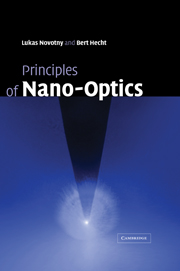Book contents
- Frontmatter
- Contents
- Preface
- 1 Introduction
- 2 Theoretical foundations
- 3 Propagation and focusing of optical fields
- 4 Spatial resolution and position accuracy
- 5 Nanoscale optical microscopy
- 6 Near-field optical probes
- 7 Probe–sample distance control
- 8 Light emission and optical interactions in nanoscale environments
- 9 Quantum emitters
- 10 Dipole emission near planar interfaces
- 11 Photonic crystals and resonators
- 12 Surface plasmons
- 13 Forces in confined fields
- 14 Fluctuation-induced interactions
- 15 Theoretical methods in nano-optics
- Appendix A Semianalytical derivation of the atomic polarizability
- Appendix B Spontaneous emission in the weak coupling regime
- Appendix C Fields of a dipole near a layered substrate
- Appendix D Far-field Green's functions
- Index
8 - Light emission and optical interactions in nanoscale environments
Published online by Cambridge University Press: 05 June 2012
- Frontmatter
- Contents
- Preface
- 1 Introduction
- 2 Theoretical foundations
- 3 Propagation and focusing of optical fields
- 4 Spatial resolution and position accuracy
- 5 Nanoscale optical microscopy
- 6 Near-field optical probes
- 7 Probe–sample distance control
- 8 Light emission and optical interactions in nanoscale environments
- 9 Quantum emitters
- 10 Dipole emission near planar interfaces
- 11 Photonic crystals and resonators
- 12 Surface plasmons
- 13 Forces in confined fields
- 14 Fluctuation-induced interactions
- 15 Theoretical methods in nano-optics
- Appendix A Semianalytical derivation of the atomic polarizability
- Appendix B Spontaneous emission in the weak coupling regime
- Appendix C Fields of a dipole near a layered substrate
- Appendix D Far-field Green's functions
- Index
Summary
The scope of this chapter is to discuss optical interactions between nanoscale systems and the properties of the emitted radiation. This is different from Chapter 3 where we considered the focusing and confinement of free propagating radiation. To link the two topics it is also necessary to understand how focused light interacts with nanoscale matter. This is a difficult task since it depends on the particular material properties, the shape of the investigated objects, and also on the strength of interaction. Nevertheless, there are issues that can be discussed from a more or less general point of view.
At the heart of nano-optics are light–matter interactions on the nanometer scale. Optical interactions with nanoscale matter are encountered in various fields of research. For example: the activity of proteins and other macromolecules is followed by optical techniques; optically excited single molecules are used to probe their local environment; and optical interactions with metal nanostructures are actively investigated because of their resonant behavior important for sensing applications. Furthermore, various nanoscale structures are encountered in near-field optics as local light sources.
To rigorously understand light–matter interactions we need to invoke quantum electrodynamics (QED). There are many textbooks that provide a good understanding of optical interactions with atoms or molecules and we especially recommend the books in Refs. [1–3]. Since nanometer-scale structures are often too complex to be solved rigorously by QED we prefer to stick to classical theory and invoke the results of QED in a phenomenological way.
- Type
- Chapter
- Information
- Principles of Nano-Optics , pp. 250 - 303Publisher: Cambridge University PressPrint publication year: 2006
- 1
- Cited by



